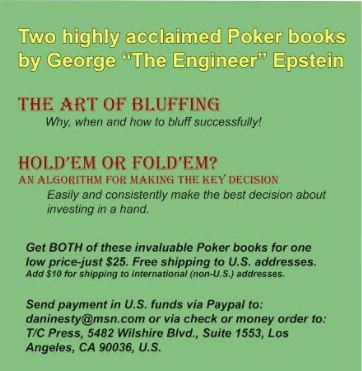When I wrote Hold’em or Fold’em? – An Algorithm for Making the Key Decision (see ad below), I wanted to make it as simple as possible. After all, there is much pressure on each player to make fast decisions and not delay the game. (You don’t want the dealer and perhaps a player or two, angrily urging you to hurry-up.) The book is intended to help readers make the most important decision in playing Texas hold’em: Looking at your hole cards, do you want to invest your chips in these two cards to see the flop?
Playing hold’em, there are many factors to be considered – card rank, whether your hole cards are suited and/or connectors; betting position; any raises; number of opponents staying in the pot; their playing traits – tight, loose, passive, aggressive; and texture of the game. This leads to a point count that makes the decision relatively easy – whether to call to see the flop or fold. The point count system may seem harder than winning a jackpot at Whichcasino.com but, in fact, it’s quite easy and can be done in a split-second while seated at the table.
The A/K/Q Rule
To make the decision even easier, we include a notation A/K or A/K/Q for unsuited, unconnected, non-pairs in the hole. These are the type of hands most often dealt.
For example, the criteria (the minimum point count) for calling the Big Blind bet to see the flop from a late position is 22(A/K/Q). What does the A/K/Q notation mean? In a late position (seats 7, 8, and 9 at a nine-player table), if your hole cards are unpaired, unsuited, non-connectors, at least one of them must be an Ace, King, or Queen. In early position, those same hole cards must include at least one Ace or King. Otherwise, as a general rule, it would be wise to fold your hand. Note: Exceptions may include when you are one of the Blinds and there has not been a raise pre-flop.
The Hold’em Caveat
You will often be dealt marginal (mediocre) hole cards. They barely meet or slightly exceed the Starting-Hand Criteria. You hesitate to make the investment. For such cases, we’ve developed the Hold’em Caveat: Muck your cards (1) if there is a raise – or likely to be one after you make your bet (you know your opponents’ playing traits); or (2) if it is not a multiway pot with three or more opponents staying to see the flop.
Explanation: With mediocre hole cards, a double bet or higher is too costly to stay to see the flop, which, most often will not improve your hand enough to warrant further investment. (Remember: Chasers are losers.) A multiway pot is necessary to ensure that the pot odds will likely be higher than your card odds – a “positive expectation” – if you do improve.
Texture of the Game
Often, you will be at a table with one or more very aggressive players. They frequently raise and re-raise. That texture makes it too expensive to stay to see the flop, especially with a marginal starting hand. In the other extreme, a tight game is likely to result in relatively few chips in the pot when you win – barely exceeding the cost-to-play. If you are seated at such games, consider a table change. Best is a well-balanced game, satisfying the Hold’em Caveat.








Comments